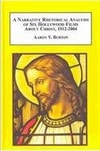- Author(s): W. Richard Comstock
- When: 1981-10
- Where: Revue française d'études américaines
The signs of religion have been mainly used in American films to mediate conflicts in the values of culture. For example, the films of D.W. Griffith were conceived by him as visionary sermons. Their content, however, is a defense of Victorian values against the laxity in traditional moral standards brought about by the rise of an industrial society and the ascendency of monopolies. On the other hand, the religious epics of C.B. DeMille, along with his other films, attempt to reconcile the piosity of Victorian standards with the greater freedom allowed in a leisure society. Most American films about priests and ministers reveal the same attempt to mediate between a work and play ethic. Yet religious signs in themselves purport to deal with concerns that transcend cultural horizons. Paul Schrader has produced an interesting study of a « transcendental style » in film that seeks to invoke the sense of religious mystery transcending culture. Yet none of Schrader's own films are successful in this respect. It is suggested that a more viable sort of religious film would contain both the function of cultural mediation and transcendent intentionality. The recent film The Hiding Place is cited as a promising example.






